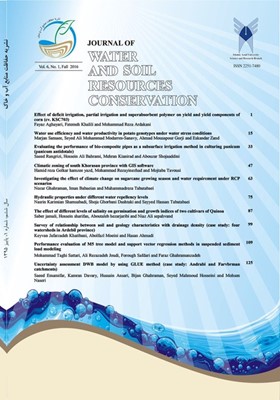Climatic Zoning of South Khorasan Province With GIS Software
Subject Areas : Farm water management with the aim of improving irrigation management indicatorshamid reza golkar hamzee yazd 1 , mohammad rezayinezhad 2 , mojtaba tavousi 3
1 - Assistant Professor
2 - دانش آموخته کارشناسی ارشد مهندسی منابع آب، واحد فردوس، دانشگاه آزاد اسلامی، فردوس، ایران
3 - Instructor
Keywords: "Climate regions, South Khorasan", cluster analysis, GIS,
Abstract :
Climatic classification of geographical areas from the distant past has been done. With the difference that in the past the traditional methods and GIS technology today with the advancement of modern methods are used. As well as the use of multiple climatic parameters in traditional methods alone would not be cardiac regions climate reality. Therefore, in recent years, researchers have tried to use the number of parameters affecting climate and more modern methods, real climate regions of the video provider. The purpose of this article the climatic regionalization of southern Khorasan Province with the method of factor analysis and cluster and Spatial Autocorrelation and more climatic elements in determining the type of weather for the area to be incorporated.To improve the results of climatic regionalization of synoptic meteorological stations facts and climatological was used. For this purpose a matrix 34 * 11 Includes 7 synoptic station and 4 climatological station. The results of this analysis showed that climate affected province of 6 factors in order of importance are, Temp (temperature), humidity of the atmosphere, windy- dust, Frost, rainy, sunny (radiation). The exercise component of about 96.5 percent of the interpretation of climatological behaviour. Cluster analysis on the factors mentioned there are 6 region of air and water in the province showed. Semi-warm and dry temperate zone, Hot and arid area, Hot and dry semi-desert area, Cold and semi-arid mountainous area, Wilderness area, Hot and dry desert area
اسماعیلی، ر.، منتظری، م. و اسمعیل نژاد م. 1390. پهنه بندی اقلیمی خراسان رضوی با استفاده از روشهای چند متغیره. نشریه پژوهش های اقلیم شناسی، سال دوم، شمارهی 8-7: 56-44.
پاپلی یزدی، ح. و جهانبانی، ر. 1381. هفتاقلیم، فصلنامه تحقیقات جغرافیایی، شماره پیاپی 64-63، زمستان 1380 و بهار 1381، مشهد.
جعفر پور،ابراهیم،1377،اقلیمشناسی،چاپ چهارم،انتشاراتدانشگاهتهران.
حاتمی بیگلو خ، مستمند ر.1390. پهنه بندی اقلیمی استان فارس، مجله رشدآموزش جغرافیا، 25 (4): 51-47.
خزانهداری، ل. 1376. واژگان اقلیم، فصلنامه تحقیقات جغرافیایی، 45: 17-24.
خسروی م، و آرمش م. 1391. پهنه بندی اقلیمی استان مرکزی با استفاده از تحلیل عاملی-خوشه ای. ،مجله علمی-پژوهشی جغرافیا و برنامه ریزی، سال بیست و سه، پیاپی 46 (2): 100-87.
دینپژوه،ی.،فاخری،ا.، مقدم،م.،جهانبخش، س.پیرنیا، م. ک. 1382.انتخاب متغیرها به منظور پهنهبندی اقلیم بارش ایران با روشهای چند متغیره. مجله علوم کشاورزی ایران، 34(4): 823-809.
سلیقه، م. و اسمعیل نژاد، م. 1388. پهنه بندی اقلیمی استان سیستان و بلوچستان، مجله جغرافیا و توسعه، 12: 10-17.
شهام، ا. و داد فر، ه. 1384. جغرافیای جهانگردی ایران، دانشگاه آزاد اسلامی (واحد تهران جنوب)، نشر طراوت، چاپ سوم، 112 صفحه.
شکوهی، ح. 1378. اندیشههای نو در فلسفه جغرافیا، انتشارات گیتاشناسی، تهران، 89 صفحه.
علیجانی، ب. 1382. اقلیمشناسی سینوپتیک، انتشارات سمت، تهران، 108 صفحه.
علیجانی، ب. و دوستان، ر. 1385. تعیین نواحی مستعد کشت زرشک در استان خراسان جنوبی با استفاده از جیآیاس، مجله جغرافیا و توسعهی ناحیهای، 8 : 33-13.
علیجانی، ب. 1383. جزوه درسی کاربرد اقلیم در برنامهریزی محیطی، گروه جغرافیا، دانشگاه سیستان و بلوچستان، 75 صفحه.
منتظری، غ. حسنعلی، م. 1383. پهنه بندی رژیم دمایی ایران با مؤلفههای مبنا و تحلیل خوشهای. مجله جغرافیا و توسعه، 4: 15-24.
مسعودیان، ا. و کاویانی. م. 1387. اقلیمشناسی ایران، انتشارات دانشگاه اصفهان، 65 صفحه.
مسعودیان،ا.1384.شناساییرژیمهای بارشایرانبهروشتحلیلخوشهای،مجلهپژوهشهایجغرافیایی،52: 24- 32.
مسعودیان، ا. 1382. بررسی پراکندگی جغرافیایی بارش در ایران به روش تحلیل عاملی دوران یافته، مجله جغرافیا و توسعه، 1 (1): 1-14.
مسعودیان، ا. 1388 نواحیه بارشی ایران، مجله جغرافیا و توسعه:13 91-79.
هاشمی عناک، ع. و حاتمی بیگلو، خ.1390. پهنه بندی اقلیمی استان خوزستان، مجله رشدآموزش جغرافیا، 26 (2):51-46.
Jaesung, k. 2004. regionalization of daily flow characteristics using GIS and spatial interpolation algorithm:the case of Brazos river basin. Journal of Climatology, 9: 400-408.
Lee J, W.S.Wong D. 2009. Statistical Analysis with ArcView GIS - Science journal, 7: 208-216.
Puvanneswaran, M.1990.climatic classification for Queensland using multivariate statistical technique.International. Journal of Climatology, 10: 591-608.
Paul A. Longley, Michael Batty .1997.Spatial Analysis: Modeling in a GIS Environment- Technology, 400.
Peel M.Finlayson B.2007.Hydrology and Earth System Sciences, 11 pp.
Reimer E,Sodoudi s.2004.Climate Model for the Catchment Area of the Elbe river With Neurio Fuzzy Method EMS annual metting abstract,European Metorological Society, 1(1): 1.
Sing, k. 1996. Space-time variation and regionalization of seasonal and monthly summer monsoon rainfall of the sub-Himalayan region and Gangetic plain of India, Indian Technology Journal, 1 (3): 10- 18.
Unal Y, Kindap, T. 2003. International Journal OF Climatology, 10: 323-340.
White, F. J. and Perry, A. H. 1989. Classification of the climate of England and Wales based on agro climatic data, International Journal of climatology, 9: 271-291.


